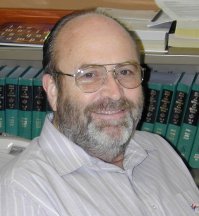Biological Science Faculty Member - Retired
 Dr. William H. Outlaw Jr.
Dr. William H. Outlaw Jr.
| Office: | (850) 644-4020 |
| Lab: | (850) 644-8568 |
| Fax: | (850) 644-0481 |
| Mail code: | 4370 |
| E-mail: |
bill@bio.fsu.edu |
Additional Resources and Information Page 
Peter H. Homann Professor of Biological Science;
Ph.D., University of Georgia, 1974
Graduate faculty status
Research and Professional Interests:
Gas exchange between a leaf and the atmosphere occurs through nonselective, adjustable stomata in the epidermis. A stoma is defined by the surrounding pair of guard cells, which are kidney-shaped epidermal cells that face each other. Certain conditions stimulate the guard cells to accumulate potassium salts. Constraints imposed by the cell-wall architecture force the cells to bow outward upon the consequent osmotic-water influx; this deformation enlarges the pore. Stomal closure occurs when the guard-cell pair loses solutes. Thus, from moment to moment, the aperture size is a compromise between the opposing priorities of permitting CO2 uptake and avoiding H2O-vapor loss. As CO2 is required for photosynthesis and water is usually the most limiting resource for a terrestrial plant, regulation of the pore size is perhaps the most crucial aspect of a plant's physiology.
Guard cells have evolved special attributes to fulfill their critical role. They are small and have enhanced capacity for ion flux. Their chloroplasts are specialized for starch storage and mobilization. Almost uniquely, they lack protoplasmic connections With adjacent cells, and their vacuole is a dynamic structure. As these cells have complex ion-flux patterns and respond to a variety of stimuli, they have become the model system for plant electrophysiology and signal transduction. The unusual pattern of primary carbon metabolism has long intrigued plant biochemists, as their differentiation has intrigued plant developmental biologists; more recently, guard cells have attracted molecular biologists. The implications of guard-cell function to the utilization of finite resources such as water and soil and to agricultural productivity justify our intense efforts to understand them better.
Although this narrative emphasizes the research in our laboratory, I am equally interested in and expend more effort in teaching undergraduates. Each fall, I have the opportunity to introduce our majors to plant biology. In alternate spring semesters, I see many of these students again in a senior-level plant-physiology course. The other formal course that I teach is an experimental laboratory module that accommodates 30 students, who independently investigate the light activation of phosphoglyceraldehyde dehydrogenase. Finally, undergraduates have the opportunity to conduct research in our laboratory and to take limited-enrollment tutorials.
Selected Publications:
Outlaw, W. H., Jr., N. N. Outlaw, and G. Bedini. 2000. A Tuscan fig aficionado. Pomona 33: 16-17 [lay publication].
Outlaw, W. H., Jr., M. Fleig, W. Grüninger, E. Magel, and R. Hampp. 2000. Observations on honey plants and Africanized honey bees in the temperate-zone state of Rio Grande do Sul, Brazil. Am. Bee J. 140: 401-404 [trade publication].
*Ewert, M. S., W. H. Outlaw Jr., S. Q. Zhang, K. Aghoram, and K. A. Riddle. 2000. Accumulation of an apoplastic solute in the guard-cell wall is sufficient to exert a significant effect on transpiration in Vicia faba leaflets. Plant Cell Environ. 23: 195-203 [cover photograph].
*Popova, L. P., W. H. Outlaw Jr., K. Aghoram, D. R. C. Hite. 2000. Abscisic acid-an intraleaf water-stress signal. Physiol. Plant. 108: 376-381.
*Aghoram, K., W. H. Outlaw Jr., G. W. Bates, J. Cairny, A. O. Pineda, C. M. Bacot, L. M. Epstein, and C. W. Levenson. 2000. Abg1--a novel gene up-regulated by abscisic acid in guard cells of Vicia faba L. J. Exp. Bot. 51: 1479-1480.
Outlaw, W. H., Jr., S. Zhang, W. R. Tschinkel, B. G. Smith, E. C. Outlaw, and N. N. Outlaw. 2001. Chemical and biological attributes of the nectar of the jujube (Ziziphus jujuba Mill.). Am. Bee J. 141: 61-62 [trade publication].
*Outlaw, W. H., Jr. and S. Zhang. 2001. Single-cell dissection and microdroplet chemistry. J. Exp. Bot. 52: 605-614.
*Zhang, S. Q., W. H. Outlaw Jr., and K. Aghoram. 2001. Relationship between changes in the guard-cell abscisic-acid content and other stress-related physiological parameters in intact plants. J. Exp. Bot. 52: 301-308 [among articles featured on cover].
*Zhang, S. Q., and W. H. Outlaw Jr. 2001. The guard-cell apoplast as a site of abscisic acid accumulation in Vicia faba L. Plant Cell Environ. 24: 347-355.
Outlaw, W. H., Jr. and N. N. Outlaw. 2001. Experiment: twenty potted fig cultivars on the Gulf Coast of the southern United States. Fruit Gardener 33(4): 15-16 [lay publication].
*Zhang, S. Q., and W. H. Outlaw Jr. 2001. Gradual long-term water stress results in abscisic acid accumulation in the guard-cell symplast and guard-cell apoplast of intact Vicia faba L. plants. J. Plant Growth Reg. 20: 300-307.
*Outlaw, W. H., Jr., and X. De Vlieghere-He. 2001. Transpiration rate. An important factor controlling the sucrose content of the guard-cell apoplast of Vicia faba L. Plant Physiol. 126: 1716-1724.
*Zhang, S. Q., and W. H. Outlaw Jr. 2001. Abscisic acid introduced into the transpiration stream accumulates in the guard-cell apoplast and causes stomatal closure. Plant Cell Environ. 24: 1045-1054.
*Outlaw, W. H., Jr., S. Zhang, K. A. Riddle, A. K. Womble, L. C. Anderson, W. M. Outlaw, E. C. Outlaw, N. N. Outlaw, and A. B. Thistle. 2002. The jujube (Ziziphus jujuba Mill.), a multipurpose plant. Econ. Bot. 56: 198-200 [back cover photograph].
*Outlaw WH Jr, Z Du, FX Meng, K Aghoram, KA Riddle, R Chollet. 2002. Requirements for activation of the signal-transduction network that leads to regulatory phosphorylation of leaf guard-cell phosphoenolpyruvate carboxylase during fusicoccin-stimulated stomatal opening. Arch. Biochem. Biophys. 407: 63-71 [cover photograph keyed to this article in December issue].
*Publication was refereed.
